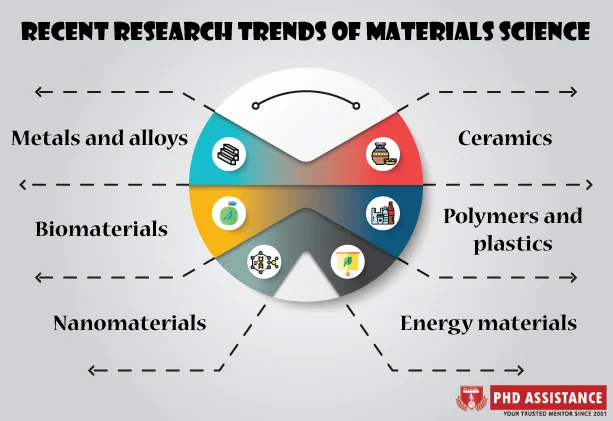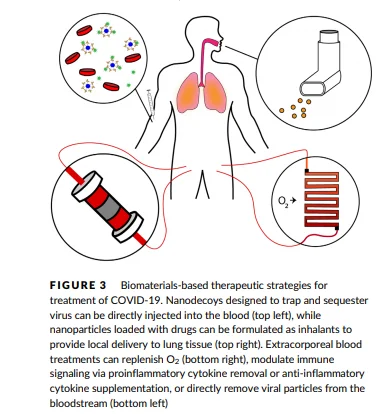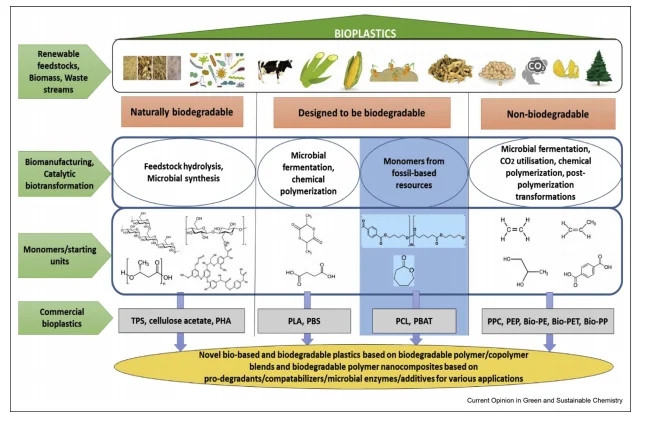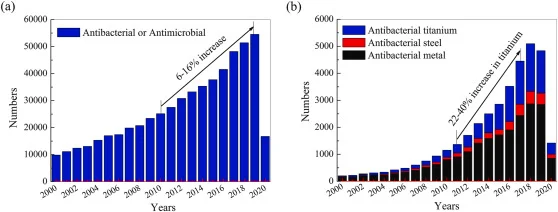Current state and prospects of materials science research
Introduction
Materials is a vast and critical area of expertise and techniques that is an integral cornerstone of contemporary technical societies, not a particular discipline. In this way, materials parallel other broad fields like energy, electronics, and medical science, where each spans several disciplines and is marked by scientific ferment and societal influence. If materials science is conducted on a small, moderate, or large scale, the people’s quality is directly related to the researcher doing it.

This report uses analysis to gain insight into the present state and future possibilities of materials research.
Recent research trends of materials science research
- i) Nanomaterials
Nanomaterials science and technology have sparked a lot of interest and anticipation in recent years. Nanostructures are also suitable for computer simulation and modelling because their scale is small enough to allow for a high level of rigour in treatment. In nanomaterials computations, the spatial scaling ranges from 1 to 1 mm, and the temporal scaling ranges from 1 fs to 1 s, with the precision limit exceeding 1 kcal mol-1. Two examples of recent successes and paradigm changes in this area are STM images of quantum dots (e.g., a germanium pyramid on a silicon surface) and the quantum corral of 48 Fe atoms arranged in a circle of 7.3 nm radius. [1]. However, tunable Superhydrophobicity from 3D Hierarchically NanoWrinkled MicroPyramidal Architectures was recently reported by Weixin Zhang and collaborators. With a touch angle of 172° and a sliding angle of 5° in a steady “Lotus” state, excellent Superhydrophobicity is achieved due to multiscale structures. Furthermore, the wear resistance and stability measurements indicate that the material will outperform in simulated extreme real-world applications [2].
Table 1. Various nanomaterial synthesis and investigation approaches
| Scale (approx.) | Synthetic techniques | Structural tools | Theory and simulation |
| 0.1–10 nm | Covalent synthesis | Diffraction methods, Vibrational spectroscopy, NMR, Scanning probe microscopies (SPM) | Electronic structure |
| <1–100 nm | Self-assembly techniques | Self-assembly techniques | Molecular dynamics and mechanics |
| 100 nm–1 mm | Processing, modifications | SEM, TEM | Coarse-grained models, hopping etc. |
ii) Energy materials
Stabilising a consistent and renewable electricity supply to satisfy the world’s rising energy demands is one of the biggest problems of the twenty-first century. With the introduction of renewable energies, there is a new market for energy storage facilities. Perovskite oxides are valuable functional materials with outstanding physical and chemical properties used in ferroelectric, piezoelectric, dielectric, energy conversion and storage, and other applications. Oxygen evolution reaction, oxygen reduction reaction,
electrochemical water splitting, metal-air batteries, solid-state batteries, oxygen separation membrane, and solid oxide fuel cells are some of the newer uses of perovskite oxides. While various behaviour descriptors for perovskite oxides have been published, such as the number of d electrons, Eg occupancy, bulk-forming energy, metal-oxygen covalency, and the location of the O–p band gravity core, there is still a need for the world and feasible reactivity descriptor.
Furthermore, high-throughput DFT calculations, machine learning, and artificial intelligence help speed up exploring new materials. Perovskite oxides’ drawbacks include low electronic conductivity at room temperature and instability in acidic environments. Adding a certain volume of metals or creating composites with strong electronic conductors, such as carbon nanotubes, graphene, or Mxenes, is one efficient way to increase electronic conductivity. Nanostructured materials with higher surface area and more open reactive sites usually perform better than bulk materials [3].

iii) Biomaterials
Biomaterials have a lot of potential for addressing COVID-19’s problems. Even though tissue engineering and regenerative medicine have long dominated the field of biomaterials, new research shows promise in offering transformative solutions to viral outbreaks [4]. Clinical perspectives are exchanged to identify current healthcare needs better than biomaterials technologies can address. The most popular screening patient samples for current SARS-CoV-2 infection is nucleic acid testing via reverse transcription-polymerase chain reaction (RT-PCR). Nanostructures may be built to replicate living cells in a different nanomaterials-centred approach. Nanodecoys constructed from cell membrane-derived materials are used to trap and sequester viruses. Biomaterials provide several possibilities for overcoming the shortcomings of current clinical techniques (Figure 1).

Figure 1. Treatment of COVID-19 using biomaterials. Nanodecoys engineered to capture and sequester virus may be inserted directly into the bloodstream (top left). In contrast, drug-loaded nanoparticles can be formulated as inhalants to administer medications to lung tissue locally (top right). Extracorporeal blood therapies may replenish O2 (bottom right), modulate immune signalling by removing or supplementing proinflammatory cytokines, or eliminate virus particles directly from the bloodstream (bottom left) [4]
iv) Polymers and plastics
Plasticisers have long been recognised for producing lightweight plastics in various industries, including the automobile industry, medical devices, and consumer goods. Because of the constantly evolving spectrum of bio-based and biodegradable polymers and rising interest in investing in the bioplastics market, global bioplastics output capacities are difficult to predict and are typically based on prediction. Natural polymers such as cellulose derivatives, thermoplastic starch (TPS), and their blends have the largest processing potential, as these components are increasingly replacing plastics in the lightweight film packaging industry. Bio monomers-derived glucose fermentation or lignin fermentation have also been used to produce commonly used commodity polymers, including polyethene terephthalate, polyamide, and polypropylene, including polyethene terephthalate, polyamide, and polypropylene for the revival of Bio-PET, Bio-PA, and Bio-PP, respectively. Using unaccounted biomass as a valuable resource and rationally engineering bioplastics to impart optimal versatility and recyclability would provide a sustainable bioplastics production value chain [5].

Figure 2. A diagram depicting the technical methods used in the production of industrial bioplastics (shaded in blue: biodegradable polymers derived from oil-based resources).
v) Metals and alloys
Stainless steel, titanium and its alloys, cobalt alloys, and other metals and alloys have all been used clinically as implant components. Still, contamination or inflammation caused by the implant is also one of the leading causes of implantation failure. Antibacterial metals and alloys have recently gained popularity due to their long-term antibacterial stability, strong mechanical properties, and biocompatibility. Antibacterial stainless steel, antibacterial titanium alloy, antibacterial zinc and alloy, antibacterial magnesium and alloy, antibacterial cobalt alloy, and other antibacterial metals and alloys were defined in detail, as well as recent advances in the design and manufacture of antibacterial metal alloys containing various antibacterial agents. Figure 3 indicates the number of publications included in Web of Science searches for antibacterial or antimicrobial study.

Figure. 3. Web of Science was used to search for antibacterial scientific publications. a) antibacterial or antimicrobial in the topic, b) antibacterial metal, antibacterial steel, and antibacterial titanium in the topic [6]
- vi) Ceramics
Ceramic-based energy storage materials have significant benefits over polymer energy storage materials, such as outstanding thermal stability, long life span, and cycle time. Dielectric capacitors, which have the fastest charging/discharging rate and the highest power density for existing energy storage devices such as supercapacitors, batteries, and electrolytic capacitors, are allowing electric energy devices. Lead zirconate titanate (PZT) is a common piezoelectric material that enables the synthesis of many materials with a broad range of properties due to the formulation of solid solutions over a wide range of Zr: Ti ratios. Also, this system accommodates a wide range of dopants for modification of crystal structure. This method also supports a wide variety of dopants for crystal structure alteration. Because of its versatility, PZT has become very popular with users and researchers all over the world. Some lead-free piezo material structures have been investigated, including BNT, BKT, KNN, and BZT-BCT. However, the advancement of lead-free piezo devices and their success with PZT devices is still in the early stages.
Future Scope
- i) It is critical to developing cost-effective, cheaper, and safer nanomaterials that will provide efficient drug loading and managed drug release of certain difficult drug moieties for which no other viable delivery method exists.
- ii) Despite the tremendous success, developing effective and controllable approaches to the scalable synthesis of nanostructured perovskite oxides remains a challenge. It is critical for commercialising effective oxygen electrocatalysts for electrochemical energy storage and conversion technologies. A multidisciplinary methodology involving conventional electrochemistry, experimental solid-state chemistry and physics, advanced characterisation, and multiscale computational modelling will be needed for future advances in this exciting area.
iii) To the environmental risk of potential pandemics, masks made of biodegradable materials or used for several purposes must be designed.
- iv) Cells and tissues are unaffected by antibacterial stainless steel, antibacterial titanium alloys, and antibacterial cobalt alloys. Surface biomodification to increase or enhance cell response is also needed, resulting in decreased antibacterial activity. As a result, the choice of surface biomodification and its effect on cell reaction and antibacterial activity should be thoroughly investigated. Even though many antibacterial pathways have been thoroughly explored so far, the antibacterial process remains a mystery. As a result, the production and preparation of antibacterial metal alloys are also heavily reliant on element alloying, including the appropriate Cu or Ag element.
References
[1] Nanostructure Science and Technology, National Science & Technology Council Report, ed. R. W. Seigel, E. Hu and M. C. Roco, Kluwer Academic Publishers, Boston, 1999; M. C. Roco, R. S. Williams and A. P. Alivisatos, Nanotechnology Research Directions, National Science & Technology Council Report, Kluwer Academic Publishers, Boston, 2000.
[2] Zhang, W., Gao, J., Deng, Y., Peng, L., Yi, P., Lai, X., Lin, Z., Tunable Superhydrophobicity from 3D Hierarchically Nano‐Wrinkled Micro‐Pyramidal Architectures. Adv. Funct. Mater. 2021, 2101068.
[3] Sun, C. W., Alonso, J. A., Bian, J. J., Recent Advances in Perovskite‐Type Oxides for Energy Conversion and Storage Applications. Adv. Energy Mater. 2021, 11, 2000459.
[4] Chakhalian, D, Shultz, RB, Miles, CE, Kohn, J. Opportunities for biomaterials to address the challenges of COVID‐19. J Biomed Mater Res. 2020; 108: 1974– 1990.
[5] Saranya Ramesh Kumar, P. Shaiju, Kevin E. O’Connor, Ramesh Babu P, Bio-based and biodegradable polymers – State-of-the-art, challenges and emerging trends, Current Opinion in Green and Sustainable Chemistry, Volume 21, 2020, Pages 75-81,.
[6] Erlin Zhang, Xiaotong Zhao, Jiali Hu, Ruoxian Wang, Shan Fu, Gaowu Qin, Antibacterial metals and alloys for potential biomedical implants, Bioactive Materials, Volume 6, Issue 8, 2021, Pages 2569-2612. https://doi.org/10.1016/j.bioactmat.2021.01.030.
 Previous Post
Previous Post Next Post
Next Post
